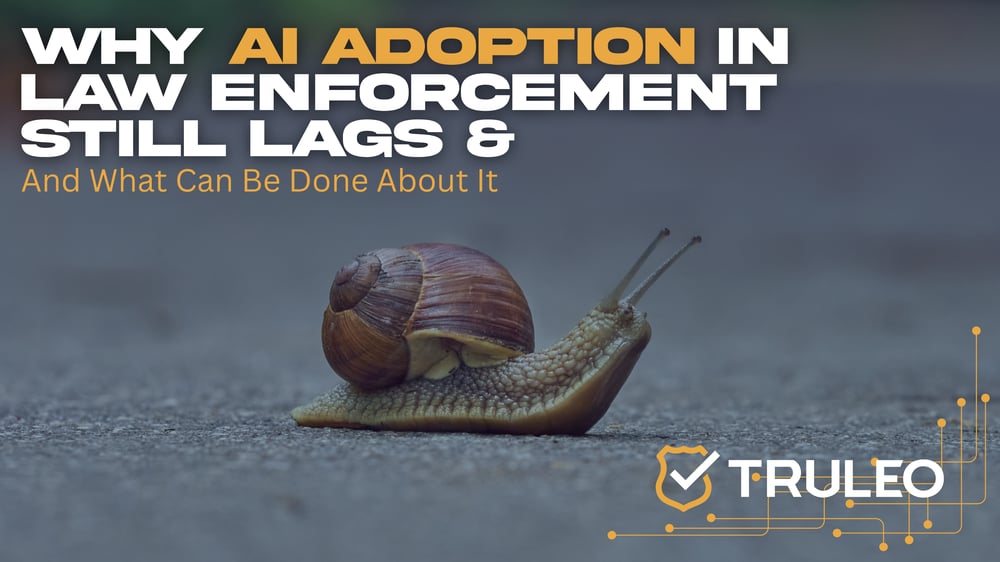Why AI Adoption in Law Enforcement Still Lags—And What Can Be Done
Discussion Technology Artificial Intelligence Jul 2, 2025 10:09:46 AM Anthony Tassone 5 min read

Artificial intelligence is transforming nearly every sector—from healthcare and finance to education and logistics. Yet government agencies, including law enforcement, remain slow to adopt AI at scale.
According to a recent article in GovTech, 64% of public-sector leaders expect cost savings from AI, and 63% believe it can improve service delivery. But fewer than 30% have implemented it in a meaningful, enterprise-wide way.
As the CEO/co-founder of TRULEO, I’ve spoken with hundreds of law enforcement leaders across the U.S. and abroad. Their hesitation isn’t about if AI is valuable, it’s about how it fits into their operations. Leaders want answers to practical questions:
- Will this save my team time?
- Will it improve the quality of work?
- Will it align with our policies and systems without adding complexity?
Here’s what we’ve learned from helping agencies deploy AI in the field—and why some departments are moving fast while others remain stuck at the starting line.
For AI to take hold in law enforcement, it can’t be a science experiment. It must solve real, everyday problems. That’s the guiding principle behind TRULEO’s intelligent AI assistant for law enforcement.
We didn’t build a generic chatbot for police. We built a mission-specific platform trained on police procedure guidelines, policies, penal codes, and real-world workflows. The result? AI that actually helps officers in the field, not just in theory, but in practice.
Officers use TRULEO to:
- Draft reports with AI police report software that ensure nothing critical is left out
- Ask AI assistants questions about policies and procedures like, “What’s the standard for a DUI arrest report in my state?”
- Talk to the AI assistant while en route to an incident to get critical details on call histories (for persons and addresses) like virtual dispatch
- Summarize long investigative files with automated case analysis
- Run structured and prioritized witness interviews using our AI crime interview assistant
- Modernize community witness canvassing with automated canvassing tools
- Review 100% body-worn camera (BWC) footage using supervisor workflows that simplify performance reviews, generate highlight reels, and assist with providing the required proofs for achieving or maintaining CALEA accreditation.
TRULEO’s AI was never meant to replace human judgment. It is a supportive tool that removes busy work, improves clarity, and enables more consistent workflows and efficiencies.
Tackling the Top Constraints to AI Adoption
The latest findings from the June 2025 EY Data and AI Report make it clear: despite enthusiasm for AI, most public-sector organizations still face significant barriers to adoption. The top three constraints?
- Data privacy and security concerns (62%)
- Lack of a digital transformation strategy (just over 50%)
- Inadequate data infrastructure
These constraints are especially challenging in law enforcement, where sensitive data, strict policies, and inter-agency protocols raise the stakes for any new technology.
At TRULEO, we built our intelligent AI assistant for law enforcement with these exact concerns in mind.
- Privacy-first design: TRULEO has a strict zero data retention policy and automatically redacts both officer and community member personal identifiable information (PII). We support on-premise and hybrid integrations with your RMS and CAD systems, keeping everything inside your existing compliance framework. TRULEO is also FBI CJIS compliant, and 100% Made in America.
- Plug-and-play integration: No complex IT lift is required. TRULEO connects with your current infrastructure, including CAD, RMS, and policy databases, eliminating the need for an expensive overhaul. Our BWC review software is also brand agnostic.
- Built-in policy alignment: Our tools don’t just help you use AI—they help you operationalize your department’s existing police procedure guidelines through smart, interactive features like police procedure AI chat and AI crime interview assistant workflows.
Most law enforcement agencies don’t need more dashboards. They need focused tools that solve specific problems—report writing, interviews, witness canvassing, training—without breaking their infrastructure or policy model.
By removing complexity and ensuring every feature maps to a known need, TRULEO helps agencies clear the most common adoption hurdles—and realize value from day one.
Breaking Down the Real Barriers
The GovTech article rightly points out that policy, infrastructure, and talent gaps are major adoption hurdles. In law enforcement, these challenges are magnified by budget cycles, staffing shortages, and strict compliance requirements.
But those hurdles can be overcome. The agencies seeing the most success with law enforcement AI tend to follow three key strategies:
- Start with the biggest pain points
Report writing remains one of the most time-consuming tasks in policing. By adopting AI police report software, some agencies have reduced time spent on narratives by 30–40%, giving officers more time for patrol, investigations, or recovery between calls.
- Choose AI tools purpose-built for policing
Generic AI platforms often miss the mark—they aren't trained to navigate legal terminology, policy-specific nuances, or the structured workflows of law enforcement.
TRULEO is different: it’s developed using real police training examples, penal codes, and procedural standards tailored to each agency’s jurisdiction.
- Measure impact from Day 1
Success can’t be vague. The agencies we work with measure outcomes like time saved per report and/or hours of BWC review, percentage of procedural compliance, number of follow-ups generated through AI crime interview assistant prompts, money saved, and more. Agencies can showcase return on investment (ROI) to both internal and external stakeholders.
A New Kind of Field Partner
The future of policing will be shaped by how well departments integrate tools that make the job easier, safer, and more consistent. TRULEO’s intelligent AI assistant for law enforcement acts as a digital partner—available 24/7—to help officers make informed decisions, file reports and solve crimes faster, and stay aligned with department policy.
Imagine a rookie officer on a domestic violence call who can instantly confirm documentation steps using our police procedure AI chat. Or a detective managing an eight-year-old case who can use automated case analysis to synthesize pages of interview transcripts, CAD notes, and RMS data in seconds.
These are real use cases happening today, not 10 years from now.
Agencies Are Ready—The Tools Just Need to Be
The Bureau of Justice Statistics (2024) reports that while over 70% of agencies are exploring digital transformation, fewer than 20% are actively using AI for fieldwork or reporting. That’s changing—but only with tools that are:
✅ Purpose-built
✅ Easy to integrate
✅ Compliant from day one
TRULEO is now live in agencies across all 50 states, with seamless integrations into RMS, BWC, and policy management systems. And we’re not pushing AI for AI’s sake. We’re answering real questions like:
- “How do I write a report that will hold up in court?”
- “What’s the correct language for a field sobriety narrative?”
- “How do we canvass a neighborhood faster?”
- “How can we scale FTO programs with limited staff?”
That’s the kind of impact AI should be delivering.
Final Thoughts
If AI is going to reshape public safety, it must be intelligent, trustworthy, and actionable—not a black box, beta test, or another dashboard that requires more work.
At TRULEO, we believe the best way to build trust in AI is to make it work—for the officer, for the department, and for the public.
Let’s stop asking whether AI is coming to law enforcement. It’s already here. The better question is: Are you ready to use it?

Anthony Tassone
Anthony comes from a proud military and law enforcement family, built communication intelligence platforms (COMINT), and serves as a board member of the FBI National Academy Associates (FBINAA) Foundation. He travels the country teaching trusted law enforcement leadership organizations—such as FBI LEEDS—about the practical use of artificial intelligence in policing. He received his bachelor’s degree in Computer Science from DePaul University and lives in Greenville South Carolina with his wife and four kids and is an avid bowhunter, rescue diver and triathlete.